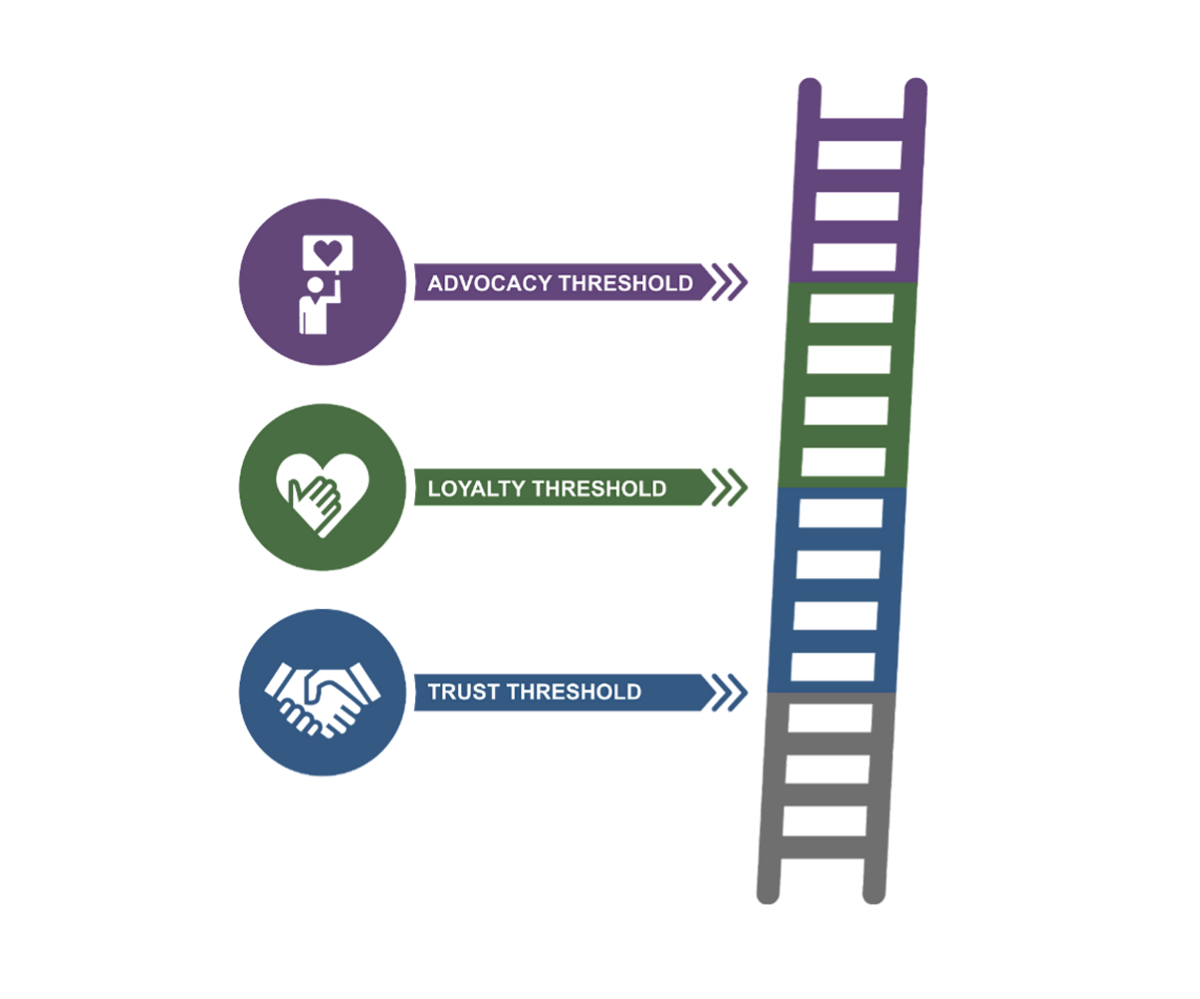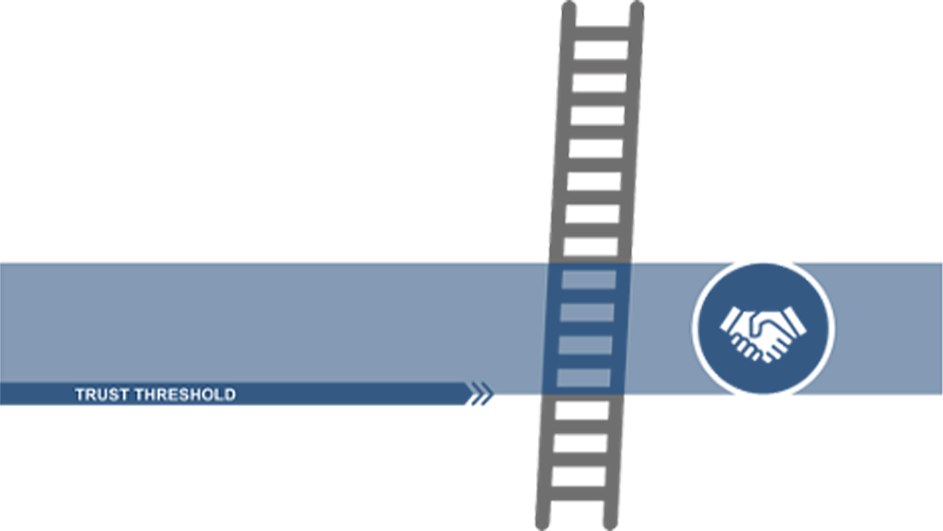On the island of Oahu in Hawai’i is a beautiful, dormant volcanic mountain with a huge crater called Koko Head. On the South slope of the mountain is a challenging hike called the “Stairs of Doom.” The trail is made up of a series of railroad ties from the base of the cone, at almost sea level, that ascends to 885 feet at the summit. It was built to be a short military cog railway for moving munitions and people to the top of the crater to defend Hawai’i during World War II. When you get to the top of what feels like a giant ladder, no matter how good of shape you are in, you are sweating buckets from the hard work. It pays off, however, in a magnificent 360 degree collection of spectacular vistas. To the East, you can see Hawai’i Kai. It includes a bay with cerulean blue water and looking South, the equally impressive Hanauma Bay crater lies below. Inside the Koko Head crater to the North is a botanical garden with spectacular fauna. Relationships are similar; They take work, purposeful investment, and they are built one step at a time.
Building Relationships
If you are fortunate, you have formed a handful of brilliant, life-long relationships with people in your life. My best friend from elementary school is a trusted advisor to me whenever I need a little honest kick-in-the-butt or have some good news about my life to share. While months may go by without seeing each other, when we do get together, we don’t miss a beat. It feels as though we were hanging out just yesterday. Consider your own friendships for a moment. How did those relationships form? Sometimes there is immediate chemistry, but in my experience, the real power in the relationship came after a long period of time that included many serial experiences. Strong, resilient relationships have ups and downs and take some amount of conflict with the commensurate resolution to become strong. All relationships, good and bad, are formed, over time and through steps.
Relationships between organizations and individuals function the same way. They take time, require a series of interactions, and can be purposefully improved. As leaders, it is imperative to invest in systems that improve each experience that we have control over. The better we understand and can communicate how relationships are both formed and broken, the more purposeful leaders can be in bringing about sustainable, strategic success for their organizations through resilient relationships.
The analogy of a ladder is a powerful tool for leaders to use to describe and measure the systematic formation of relationships for teams and organizations. It is a memorable, teachable framework that demonstrates the strategic long-term success that can be applied and will help teams collaborate more powerfully. Similar to a ladder, relationships occur in stages and move through different phases, like trust, loyalty, and ultimately, advocacy for organizations.
The Ladder

The Trust Threshold
The first stage in any relationship is awareness. When the existence of the organization and its purpose is first discovered, it is always through experience. The first goal of the organization, in the context of the relationship, is to move into a trusting relationship with the person. This is true for all of the organization’s human relationships with its customers, vendors or employees.
This can be called the “Trust Threshold,” where we have purposefully built enough trust, through experiences, to earn enough confidence for the person to trust us.

The Loyalty Threshold
The next goal is to continue to produce experiences over time that move the relationship into a place of loyalty. This occurs when there has been enough education that the person is aware of the breadth of possibilities in which the organization can provide value and there have been enough experiences to warrant recurring engagement with little assessment or challenge.
This can be called the “Loyalty Threshold,” where we have thoroughly earned the right to ongoing engagement and the person doesn’t consider alternatives by default.

The Advocacy Threshold
The ultimate demonstration of a relationship between an organization and the people that it serves is one of advocacy, where each is investing in the other’s long-term future. This only occurs when there have been enough experiences, that the person is willing to actually perform investment behaviors that are meant to help the organization thrive.
When these behaviors are witnessed, the organization has earned them, and we call this tipping point in the relationship the “Advocacy Threshold.”

The Analogy
Here are a few detailed explanations for why and how this ladder analogy works:
1. Relationships require experiences (rungs).
Most of us are looking to build positive, productive relationships in our lives and want to create good experiences for those around us. And, we want to have good experiences ourselves. It is important to recognize and acknowledge that the way we get traction on the relationship ladder is through experiences. To form opinions, make judgments, and move up the ladder, something must happen that influences the person in a way that shifts the relationship. Often, this movement happens subconsciously, without them even realizing it is happening. Without a series of experiences, people will not have an opportunity to move up or down the ladder. People are not generally sitting around thinking about their relationships with companies. Relationships are powerfully built by producing impactful experiences.
This means that we should purposefully work to maximize the quality of each experience by looking at it as an opportunity to move them up the ladder, with each experience functioning like a rung. Of course, you might try to maximize the number of experiences or speed up the frequency of them as well. However, trying to intercede and interrupt your customer’s journey may feel manipulative, like spam. You are almost always better off in the long run investing in systems that improve the experience at each rung of the ladder.
2. The micro-experiences matter.
Even the small, micro-experiences that occur are opportunities to move the other up or down the ladder. Every email sent, every phone call made, every user interface built into your organization’s software, and every small interaction on the retail floor serves as an opportunity to improve the relationships the organization has with the people it serves.
Imagine if everyone in the organization acknowledged the importance of the micro-experiences we produce for our customers? How might it change the conversations that happen between employees and customers or even between employees? When teams pay attention to the impact of each experience they produce, they are less likely to allow their current mood, the events of the day, or other circumstances to impact our customer’s experience. Teams will pay closer attention to the details of their interactions when they understand why and how relationships work.
3. It is hard to ascend by skipping steps.
Relationships that have resiliency take time to build. To climb a ladder to the top, teams must invest and do the work it takes to get there. You can learn to ascend the ladder faster by building muscle memory and working those muscles out, but you still have to climb it. Resilient relationships require you to play a long game and make strategic investments in the foundation of the ladder (trust) and build up from there, on your customer’s timeline. Invest in the steps that work best for your customers. Over time, there will be inevitable moves down the ladder. Sometimes, they may be “several-rung” drops. Those big drops can be seen as opportunities for big recoveries and jump up the ladder. Teams can be taught how to engage and move into action when movement down the ladder is observed.
4. Measuring progress with granularity is helpful.
Breaking the relationship ladder up into segments like “trust, loyalty, and advocacy” provides a level of granularity that is valuable for teams of people because it is a long game. Most organizations will quickly recognize that moving everyone in your ecosystem into an advocacy relationship is nearly impossible. People are complex, value different things, and are otherwise occupied with their lives. We have found that there will always be some people whom you may never get to the level of advocacy. That is ok, as long as you can identify those who can; then, simply focus on those folks.
Segmenting the measurement of relationships into multiple steps gives us “relationship granularity” that allows us to see progress at lower levels. Since this is a long process that takes time to achieve, having some level of granularity is valuable for the team to see the progress of each relationship and to see their progress at scale.
5. It’s easy to fall off if you aren’t paying attention.
One misstep is all it takes to fall off of a ladder. When the relationship ladder is working, it is an infinite game where there are no losers. It creates a sustainable environment of mutual gain where each is investing in the other. If the team fails to keep their eye on the goal of optimizing the relationship, it generally manifests as apathy or complacency. From there, progress can stall or the customer can fall off the ladder entirely and be blindsided when they suddenly shift to a competitor.
Paying attention to progress and movement is an antidote to falling off the ladder. Great relationships are built with intention and purpose by everyone who interacts with customers from the leader to the front-line team members in the organization. Keeping everyone focused on the strategic intent of creating more advocates is a powerful way to avoid falling off the ladder.
6. If the bottom of the ladder is rotten, it is dangerous to climb.
The base or foundation of a ladder is critical to its function. If the bottom breaks or rots, you have a major problem. Relationships are similar and they start with trust. Trust is shown at the base of the ladder because it serves as the foundation of all organizational relationships. When trust is broken, it doesn’t matter how high you have gotten, you can lose the entire investment in a flash. If you are working on the higher levels of the relationship, on a foundation that is not firm and trustworthy, it is only a matter of time before the ladder collapses and personal relationships can be damaged along the way.

7. It’s safer if you have help.
Anyone who has used a ladder on soft ground knows how important it is to have a set of helping hands to keep the ladder stable. Relationships for organizations function the same way. When there are multiple touch points and systems in place that are all working on the same goal, it diversifies the relationship and improves organizational resiliency.
Relationships that are 1:1 between people are definitely valuable, but when you have multiple people in an organization with strong 1:1 bonds between multiple people, you have something really special and deeply resilient. It is much safer for the organization when there are multiple people shoring up the relationship ladder.
8. The real work begins when you get to the top.
Much like a ladder in real life, the relationship ladder is a tool that helps you strategically ascend. Once you get to the top, the real work of keeping the gutters clean, the lights functioning, and the roof clean and functional begins. Relationships work the same way. Your strongest organizational relationships will atrophy with time if they are not tended to. They require thoughtful and purposeful reinvestment in the advocacy relationship over time.
There are lots of things that teams can do to periodically check in and make sure advocacy relationships continue to thrive. It’s hard work, but few investments will pay off more than building real human relationships in your organization’s ecosystem.
What Can You Do About It?
First and foremost, the organizations that are best at building advocacy relationships with their customers deeply understand their customers and the problems they solve for them. This allows them to understand and build empathy for the customer at scale. The better you know your customer, the easier it becomes to find more people to connect with that look like your current advocates. It becomes a self-fulfilling prophecy. Imagine how much easier business becomes when you have an ever-improving percentage of your customers who act like advocates. Marketing becomes easier and less expensive. Sales come faster. Ideas flow more frequently and with more depth from customers to your products and services. Life is good.
Second, acknowledge that every decision that impacts your customers, or your team should be made with care and concern for the impact it will have on the experience. The details matter and the best leaders work to model this belief system. They work the important micro-experiences into their culture and model these behaviors in their own interpersonal work relationships.
References
The Relationship Ladder (Earlier Version), by Sean Flaherty (2016).
The Calculus of Trust, by Sean Flaherty (2021).
Measuring Loyalty, by Sean Flaherty (2020).
An Advocacy Strategy, by Sean Flaherty (2021).
Great Visions Unlock Human Potential, by Sean Flaherty (2021).

Sean Flaherty is Executive Vice President of Innovation at ITX, where he leads a passionate group of product specialists and technologists to solve client challenges. Developer of The Momentum Framework, Sean is also a prolific writer and award-winning speaker discussing the subjects of empathy, innovation, and leadership.



